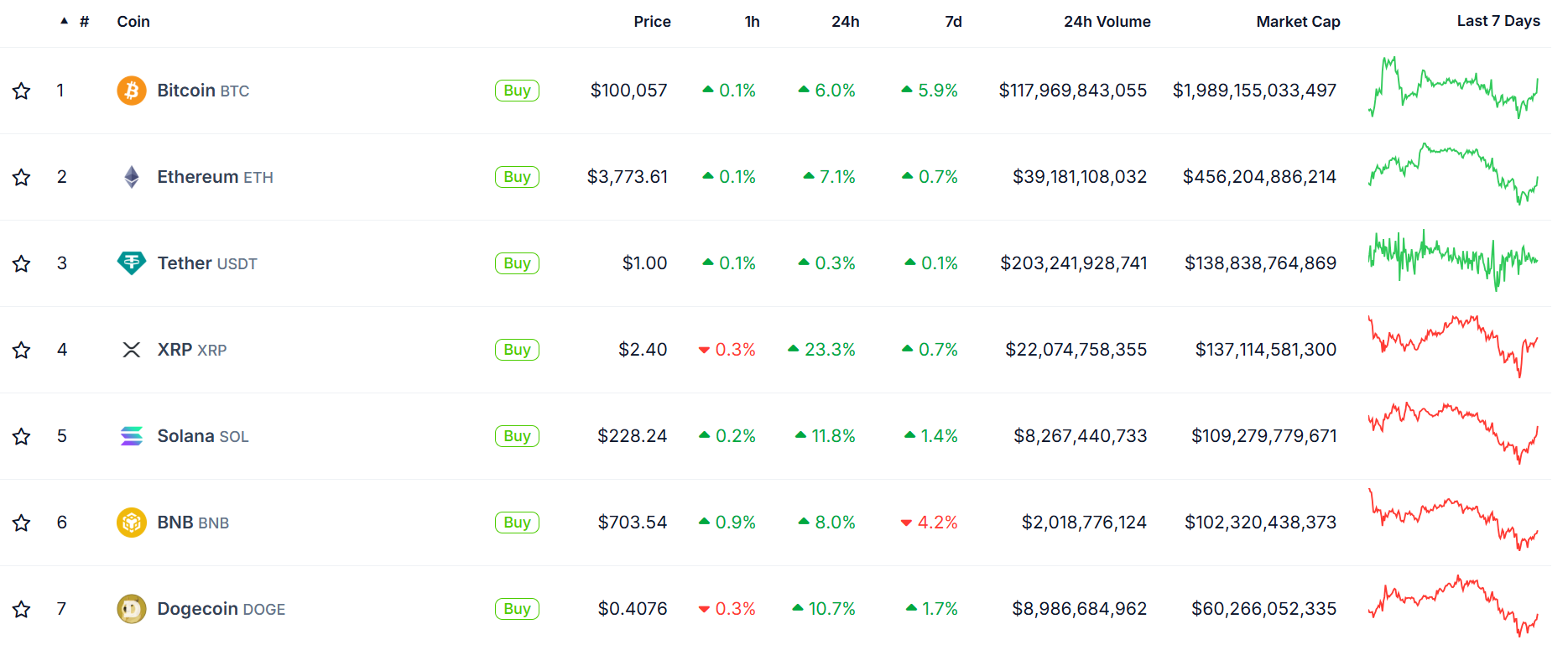- Bitcoin reclaimed the $100,000 level as November US inflation data aligned with expectations.
- Market participants expect the Fed to cut rates by 25 basis points due to stable inflation figures.
- The general crypto market also saw an increase of over 4%, with major altcoins like XRP, SOL, and ADA leading the rally.
Bitcoin (BTC) surged above $100,000 on Wednesday after the release of US Consumer Price Index (CPI) data for November, which was in line with expectations at 2.7%. Crypto investors were quick to react to the report, as market participants now expect the Federal Reserve (Fed) to cut rates by 25 basis points (bps) next week.
Bitcoin Surpasses $100,000 as CPI Data Drives Crypto Market Rally
US CPI data for November rose to 2.7% year-on-year from 2.6% in October, in line with market expectations. The monthly CPI rose 0.3% in November, slightly more than 0.2% the previous month. The core CPI stood at 3.3%, unchanged from October’s increase.
The CPI data was in line with expectations as market participants anticipate a 25 basis point interest rate cut by the Fed next week. A possible rate cut by the Fed could boost demand for risky assets like cryptocurrencies, as investors begin to favor higher-yielding investment products.
This is evident in Bitcoin’s 6% rebound above $100,000 on Wednesday following the CPI release. The crypto market has also seen a significant increase, increasing by over 4% in the last 24 hours.
Major altcoins leading the rally include XRP, Solana (SOL), and Cardano (ADA), which saw gains of 23%, 11%, and 16%, respectively.

Main cryptocurrencies | CoinGecko
Other sectors also reacted well to the inflation data. Several meme coins, including Dogecoin (DOGE), Shiba Inu (SHIB), dogwifhat (WIF), BONK, and FLOKI, saw double-digit gains.
Likewise, the artificial intelligence token sector surged over 7%, with top AI tokens rising over 10%.
However, despite immediate signs of a crypto rally following the CPI data, James Toledano, the COO of Unity Wallet, warned that investors should exercise caution when dealing in assets like Bitcoin, due to its volatile history.
“Bitcoin has a history of extreme volatility, and this calls for caution because corrections are always coming,” Toledano told FXStreet. “The pendulum swings both ways and for newcomers to Bitcoin, I advise against going all-in when the price hits a six-figure all-time high, especially when sugar’s latest success is largely based on sentiment towards of the new American administration.
FAQ Bitcoin, altcoins and stablecoins
Bitcoin is the largest cryptocurrency by market capitalization, a virtual currency designed to serve as money. This payment method cannot be controlled by any person, group or entity, eliminating the need for third party participation during financial transactions.
Altcoins are any cryptocurrency except Bitcoin, but some also consider Ethereum to be a non-altcoin because it is from these two cryptocurrencies that the fork occurs. If this is true, then Litecoin is the first altcoin, derived from the Bitcoin protocol and, therefore, an “enhanced” version of it.
Stablecoins are cryptocurrencies designed to have a stable price, with their value backed by a reserve of the asset they represent. To achieve this, the value of a stablecoin is linked to a commodity or financial instrument, such as the United States dollar (USD), whose supply is regulated by an algorithm or demand. The main purpose of stablecoins is to provide an on-ramp for investors willing to trade and invest in cryptocurrencies. Stablecoins also allow investors to store value since cryptocurrencies, in general, are prone to volatility.
Bitcoin dominance is the ratio of the market capitalization of Bitcoin to the total market capitalization of all cryptocurrencies combined. This gives a clear picture of the interest in Bitcoin among investors. Strong BTC dominance typically occurs before and during a bull run, during which investors resort to investing in relatively stable, high market cap cryptocurrencies like Bitcoin. A decline in BTC dominance typically means investors are moving their capital and/or profits into altcoins in search of higher returns, which usually triggers an explosion in altcoin rallies.




